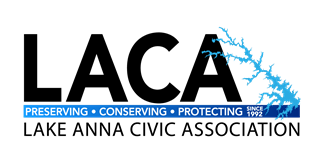By Harry Looney - October 2020
As part of our ongoing efforts to prevent Harmful Algae Blooms (HABs) from forming on Lake Anna, LACA established an academic partnership with the Environmental Studies Program at Randolph-Macon College (R-MC) in early 2020, initiating a research effort to sample, measure and analyze nutrients (phosphorous, orthophosphates and nitrogen) in the lake sediment. Dr. Mike Fenster and Dr. Chas Gowan lead the R-MC research program that will involve sediment sampling in the lake north of the 208 bridge.
.jpg) The R-MC research program began in August when the students returned to campus and started the fall semester. R-MC’s fall semester is broken into two parts due to COVID-19 restrictions and school protocols. The Environmental Studies course was only 8 weeks in duration, so the faculty and students had to fit a considerable amount of planning and preparation into a short period of time.
The R-MC research program began in August when the students returned to campus and started the fall semester. R-MC’s fall semester is broken into two parts due to COVID-19 restrictions and school protocols. The Environmental Studies course was only 8 weeks in duration, so the faculty and students had to fit a considerable amount of planning and preparation into a short period of time.
The R-MC research program is focused on sediment collection in the main tributaries from the 208 bridge to the northern headwaters of the lake (North Anna River, Pamunkey Creek and Terry’s Run). We included several creeks in the upper lake area as well (Plentiful Creek, Foremost Run and Ware’s Creek). The R-MC research program will be conducted over several academic semesters. All data will be analyzed by the students to quantify the levels of nitrogen, orthophosphates, and phosphorus in the sediment. We expect to have initial insights after completion of program activities in the spring semester (April 2021). All data, insights and results generated by the R-MC research will be provided to LACA for our internal review. The R-MC research in the spring semester will focus on data analysis and visualization to inform our understanding of how the nutrients in the sediment can be made available to cyanobacteria that are naturally present in the lake.
The R-MC fall semester execution plan was impacted significantly by COVID-19, so the students were not able to go out on the lake to collect samples. LACA and the Virginia Department of Environmental Quality (DEQ) implemented a back-up plan and were able to collect samples at nine locations. The data generated by this sampling effort will be used in the continuing R-MC research effort. LACA thanks the R-MC faculty and students for their efforts under such unfavorable, extreme conditions. LACA also thanks DEQ for their efforts in stepping in to collect the sediment samples when COVID-19 impacted the R-MC sampling plan.
Results from the R-MC research project will be shared with the Lake Anna Advisory Committee (LAAC) that is executing a comprehensive study to determine the cause of our recent harmful algae blooms (HABs) and to inform course-of-action development into potential remediation actions that could be taken. Phase one of the LAAC project focuses on the North Anna River from Holladay Bridge west to the upper reaches of the lake. The objective of LAAC’s robust study is to determine the magnitude of phosphorus and nitrogen loading from external (from the streams) and internal (in the water column and sediment) sources. The tasks that will be executed to achieve their objective include mapping the North Anna River watershed, mapping of the lake bottom and sediment sampling.
Sediment nutrient loading is one of the key knowledge gaps that LACA, LAAC and DEQ have identified with our understanding of the lake dynamics. Both the R-MC academic research effort and the LAAC project are working to fill this knowledge gap so our decisions are based on data and science informed by relevant, current data.
Interested LACA members are welcome to volunteer in support of this research program. Contact the Water Quality Committee leads if you are interested in learning more or volunteering to support this research program.
